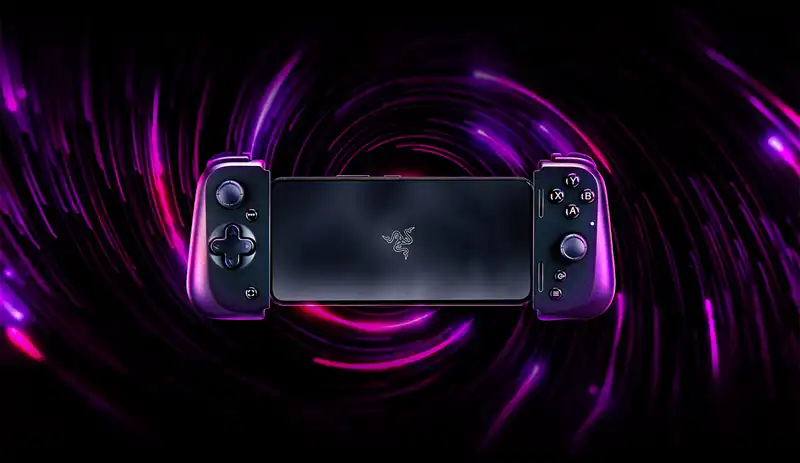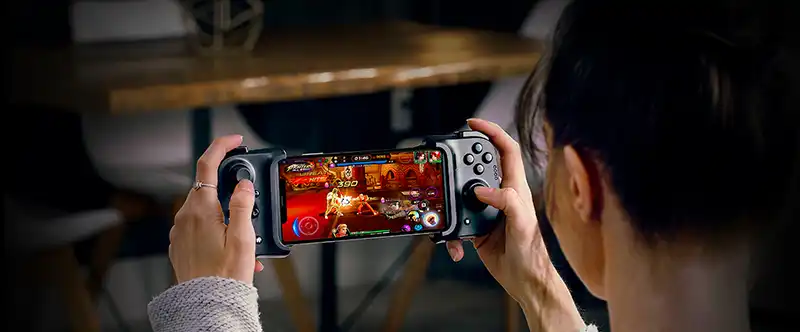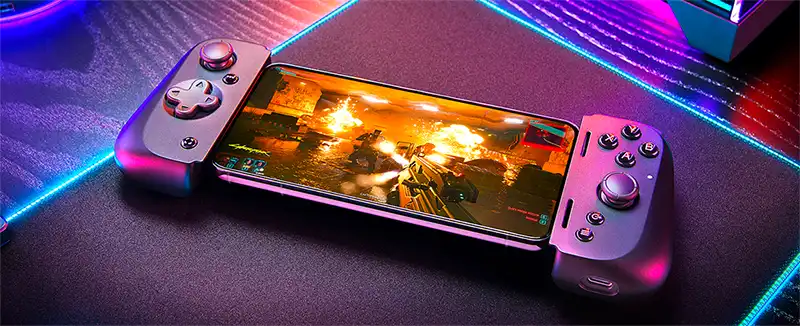You can also be interested in these:
- Razer BlackWidow V4 Pro keyboard review
- Razer Blade 15 2018 H2 review
- Playing PS3 games on PS5: Backwards compatibility
- How to play retro games on my PC
There has never been more interest in mobile gaming. You can unwind with a light puzzle, feed your tower defense compulsion, or take a little break from competitive shooter action. Everyone can find something these days. The newest smartphones can run demanding, graphically impressive games, thus ports of well-known PC and console games are becoming more and more frequent, although using touchscreen controls is not always enjoyable. You require a portable game controller.
With the launch of the Kishi V2 mobile controller in the middle of 2020, Razer was successful in converting smartphones into cloned Nintendo Switch systems. With its ingenious design, your phone gets placed in the middle of two controllers.

Not to mention that it was a more convenient, console-like method to use cloud streaming services like xCloud, Stadia, and others, as well as play mobile games. The Razer Kishi V2 is advertised by Razer as having “universal compatibility,” and the company has confirmed that the device’s cushions are detachable if necessary. A great thing about this game console is that long lengths of time can be spent using it comfortably.
In addition to that, the Razer Kishi V2’s design replaces its predecessor, which was more like the Backbone One controller for iPhones than a pair of third-party Nintendo Switch Joy-Cons. It could be separated by pulling the two tabs on the back.
A bit about the Razer Kishi first generation
The Gamevice gamepad, which debuted in 2017 for the iPhone 6 generation, was rebranded as the Kishi by Razer. A controller developed by Razer and Gamevice was available for Android devices with a USB Type-C port and iOS devices with a Lightning port.

The 2020 Kishi V1’s best features, like those of other Gamevice controllers, included sturdy joysticks and an easy-to-fold split design that allowed you to clasp its halves together when it wasn’t attached to a phone. They helped to pack it more conveniently in a busy suitcase. Its D-pad and ABXY button array were both soft, and the strain on the analog triggers felt cheap.
Flexibility
The original Razer Kishi was a fantastic mobile gaming controller, but inserting your phone into it could be a hassle. Before you could put the phone into the controller, you had to press down release latches so a stretchable support band could floppily fall back. Once you took the phone out, it was a nuisance to spread out and then curl back up.
In contrast to the flexible bridge of the original pad, the Razer Kishi V2 has been updated to feature a more durable sliding bridge. Simply pull one of the controller’s sides to extend the bridge and insert the phone into the Razer Kishi V2 to use it.
Even though it’s the major selling point of the new technology, this idea isn’t original. The Backbone One, another popular mobile gaming controller, and the Razer Kishi V2 share a lot of similarities in terms of design.
Button functions
The V2 switches, which are the components under the buttons that register when you push them, have been redesigned, replacing membranes with microswitches. Such function is seen in Razer’s Wolverine console pad. The major inputs remain intact.
Aside from a simpler look, the Razer Kishi V2 adds three new buttons: an Options button, two multifunction buttons that can be remapped, and a specialized Share button below the D-Pad for screenshots and gameplay capture. A dedicated “Share” button has been added to the front of the function keys, and two programmable bumpers have been placed beside the shoulder triggers.

The Razer Kishi V2 has two programmable microswitch buttons close to the triggers in addition to a capture button, unlike the original. This is a good accessibility and utility feature because these buttons are excellent substitutes for gamers who find it difficult to press the analog thumbsticks for L3 and R3 inputs.
The menu and Razer Nexus button locations of the Razer Kishi V2’s layout are at the biggest fault. Above the start/menu button on the Razer Kishi V2 is a menu and a Razer Nexus button. This button will take you to the Razer Nexus app. If one only wants to pause or start a game, one can frequently find themself unintentionally pressing the Nexus button and opening that app. This can be frustrating sometimes.
Similar to the Kishi V1, the Kishi V2 supports USB-C passthrough charging. It allows you to charge your phone by inserting a cable into the grip’s lower right corner.
Razer Kishi V2 App
Razer also revealed that a brand-new Nexus app would be available for free. It was made specifically for the Kishi V2 and is advertised as enabling controller owners to quickly access installed games, modify the control settings for the Kishi V2, or easily live stream their video on YouTube or Facebook. In addition to that, Razer stated that the Nexus app will eventually get functionality for Twitch streaming.
Kishi V2 owners may now only remap M1 and M2, a pair of tiny, clicky buttons located near the gamepad’s bumpers, via the official Razer Nexus app. However, the Razer Nexus app isn’t really useful in its current condition unless you have numerous games installed on your phone but haven’t grouped them all.
Gaming experience
You’re going to require a controller that can manage increasingly difficult and console-quality mobile games, like Diablo Immortal. Due to its low latency and comfortable feel, the Razer Kishi V2 seems like one of the best controllers to use for that. Games like Stardew Valley and Shatter Remastered that are natively running on the phone detected the controller right away and continued to play without any issues.
Bloodrayne 2 on Amazon Luna, TMNT: Shredder’s Revenge on Xbox Game Pass, and Doom Eternal on Google Stadia have all demonstrated how fantastic this cloud gaming controller is and how little additional visible latency it will contribute.
The Razer Kishi V2 is a good controller to use if you have an Xbox Game Pass Ultimate subscription and want to test how the cloud-supported games look and play on Android.
Conclusion
The launch of the Kishi V2 has forced Gamevice to redesign and re-release the Kishi V1 as a new $49.99 gamepad for Android and iOS. Even though, it still has a quality feel that is arguably worth its expensive price. For a practical, if mushy, phone-clasping controller that is now compatible with more, larger devices, that is not a bad price.
More stories like this
- Razer BlackWidow V4 Pro keyboard review
- Razer Blade 15 2018 H2 review
- Playing PS3 games on PS5: Backwards compatibility
- How to play retro games on my PC
- Do we need a gaming chair with LED lights?
- All about the Nvidia G-Sync technology
